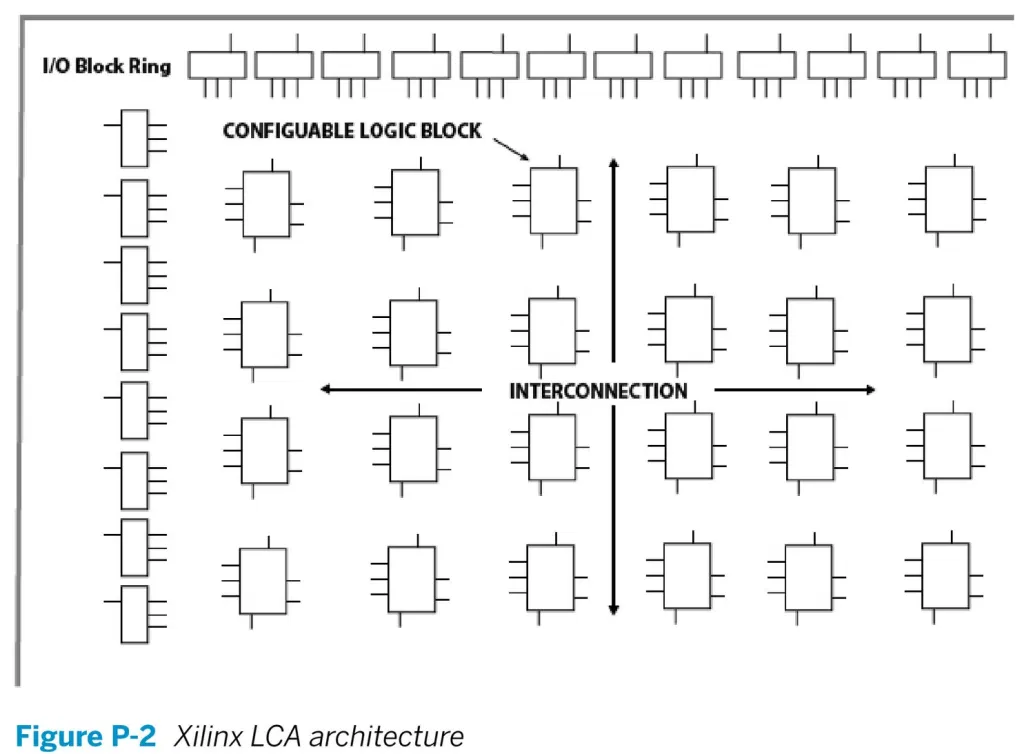The FPGA industry sprouted from programmable read-only memory (PROM) and programmable logic devices (PLDs). PROMs and PLDs both had the option of being programmed in batches in a factory or in the field (field-programmable). However, programmable logic was hard-wired between logic gates.
Altera was founded in 1983 and delivered the industry’s first reprogrammable logic device in 1984 – the EP300 – which featured a quartz window in the package that allowed users to shine an ultra-violet lamp on the die to erase the EPROM cells that held the device configuration. In December 2015, Intel acquired Altera.
Xilinx Inc. was founded in 1984, and as the result of numerous patents and technology breakthroughs, the company produced the first family of general-purpose, user-programmable logic devices based on an array architecture. It called this technology breakthrough the Logic Cell Array (LCA), and with this the Xilinx XC 2000 family of FPGAs was born.
You can think of an LCA as being made up of three types of configurable elements: input/output (I/O) blocks, and logic blocks, and an interconnect matrix.

From these, a designer can define individual I/O blocks that interface to external circuitry. You can think of these as configurable pins of ports.
The designer can also use logic blocks, connected together through the interconnect matrix, to implement logic functions. These functions can be as simple as a counter or as complex as a microcontroller core. In a way, the interconnect matrix is like the wires on a breadboard that connect everything together — but completely programmable.
Before there were FPGAs, you needed to use dozens of discrete ICs on a circuit board, or sometimes even hundreds of ICs on multiple circuit boards, to accomplish the hardware functionality you can achieve today with one FPGA device.
Xilinx co-founders Ross Freeman and Bernard Vonderschmitt invented the first commercially viable field-programmable gate array in 1985 – the XC2064. The XC2064 had programmable gates and programmable interconnects between gates, the beginnings of a new technology and market. The XC2064 had 64 configurable logic blocks (CLBs), with two three-input lookup tables (LUTs).
In 1987, the Naval Surface Warfare Center funded an experiment proposed by Steve Casselman to develop a computer that would implement 600,000 reprogrammable gates. Casselman was successful and a patent related to the system was issued in 1992.
Altera and Xilinx continued unchallenged and quickly grew from 1985 to the mid-1990s, when competitors sprouted up, eroding significant market share. By 1993, Actel (now Microsemi) was serving about 18 percent of the market. By 2013, Altera (31 percent), Actel (10 percent) and Xilinx (36 percent) together represented approximately 77 percent of the FPGA market.
The 1990s were a period of rapid growth for FPGAs, both in circuit sophistication and the volume of production. In the early 1990s, FPGAs were primarily used in telecommunications and networking. By the end of the decade, FPGAs found their way into consumer, automotive, and industrial applications.
Companies like Microsoft have started to use FPGAs to accelerate high-performance, computationally intensive systems (like the data centers that operate their Bing search engine), due to the performance per watt advantage FPGAs deliver.
Microsoft began using FPGAs to accelerate Bing in 2014, and in 2018 began deploying FPGAs across other data center workloads for their Azure cloud computing platform.